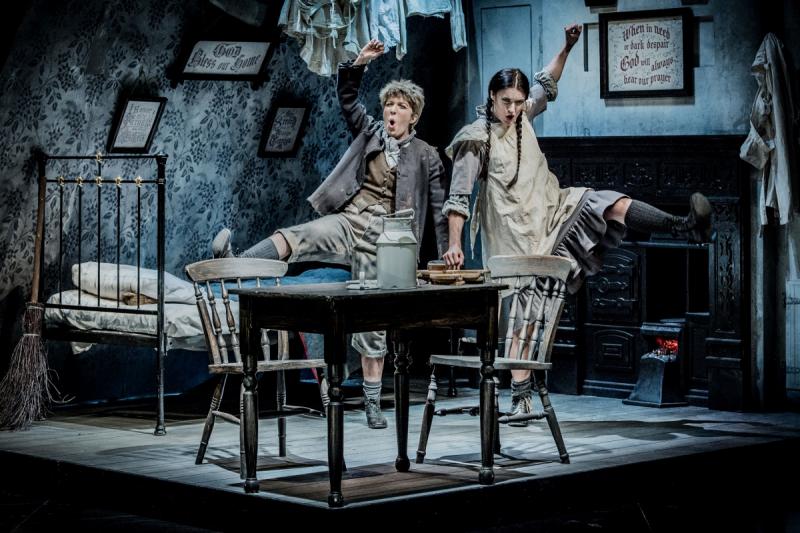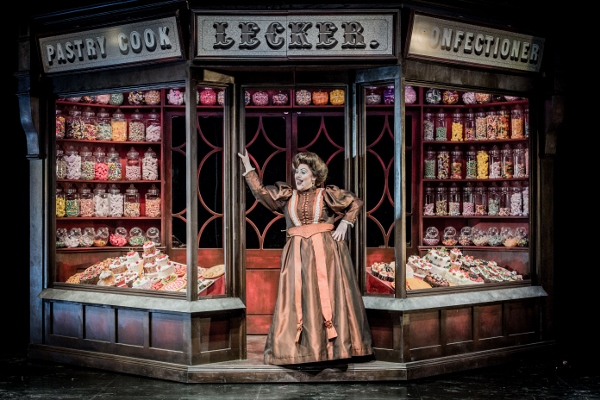Hansel and Gretel, RNCM, Manchester review – an urban dream | reviews, news & interviews
Hansel and Gretel, RNCM, Manchester review – an urban dream
Hansel and Gretel, RNCM, Manchester review – an urban dream
Beautiful singing, orchestral warmth and ingenious re-imagining of the fairytale opera

Engelbert Humperdinck’s Hansel and Gretel is a ‘"fairytale opera" (its composer’s description), and yet one characteristic frequently commented on is its "Wagnerian" scoring. For this production, with David Pountney’s English translation, the RNCM used Derek Clark’s reduced orchestration.
Good idea, because the college has always been concerned that still-maturing voices should not be forced into trying to dominate massive orchestral sounds, and with that in mind has in recent years often provided surtitles for the audience to follow, even when the sung language was English. This time they didn’t do that, and I was concerned at first as to why. I think the answer may lie in the fact that Stephen Medcalf’s production – which has been created in collaboration with Grange Park Opera – doesn’t take the text particularly literally (though in spirit it’s spot-on). So it doesn’t actually matter too much whether you hear every word: the important thing is that you follow the parallel scenario. In the case of the cast I heard (there are two complete casts), Fiona Finsbury (Gretel), Rebecca Barry (Hansel) and Kimberley Raw (the Witch, pictured below) were excellent in diction, but the other principals had other virtues and all gave strong performances.
This urban reimagining has all the same sentimental warmth as the original
So what’s the story this time? Well, we’re in the 1890s, when the piece was written – no clever update of the children’s adventure into a cyberspace one, as in Opera North’s recent version – and the family are clearly poor and living in urban squalor. Dad’s still a drunk, and mum, if she hasn’t given up altogether, is struggling. When the kids are sent out to scrounge (which they do with all the professionalism of the Artful Dodger among the city crowds), they’re in a "forest" of gaslamps, and that’s where they say their prayer and drop off to sleep as darkness falls.
I wouldn’t have known it was meant to be Manchester if I hadn’t read the press release, but no matter: perhaps I should have realized that the name above the Witch’s little housey, here transformed into a sweets and pastry shop – Lecker – would be just right for one run by one of the many German émigrés in the Manchester of the late 19th century. Is the rest supposed to be a dream? Perhaps it is, as the Witch’s Konditorei, emerging from nowhere, transforms – and this really is a coup de théâtre – into a magnified version of the one-room home the children started off in (like in Cats, the larger-than-lifesize sets make you enter another world).
Designer Yannis Thavoris, who also did wonders for the RNCM’s Cendrillon last December, has created this masterly effect. The opera’s moral lesson, sung first by Gretel and finally by everyone, that "When in need or dark despair, God will always hear your prayer", is first seen as a sampler above the fireplace of the children’s home – which is of course a very good place for sober thoughts when red-hot danger lurks beneath... Thavoris also provides a small army of gaslamp lighters for the outdoor scene, with glimmering ends to their poles like glow-worms – and who later turn into guardian angels, as we see from woolly wings sewn on their backs. The Sandman is a strange and foreign-looking pipe-smoker (not sure where that leaves the fairy dust he provides to close children’s eyes for sleep), and the Dew Fairy is a morning milkman from "Dew Farm Dairy". True to the original, at the end the Witch is changed into a gingerbread biscuit from which all the unenchanted children can take a bite.
Thavoris also provides a small army of gaslamp lighters for the outdoor scene, with glimmering ends to their poles like glow-worms – and who later turn into guardian angels, as we see from woolly wings sewn on their backs. The Sandman is a strange and foreign-looking pipe-smoker (not sure where that leaves the fairy dust he provides to close children’s eyes for sleep), and the Dew Fairy is a morning milkman from "Dew Farm Dairy". True to the original, at the end the Witch is changed into a gingerbread biscuit from which all the unenchanted children can take a bite.
But this urban reimagining all has the same sentimental warmth as the original – and that is true of the re-orchestration, too. In the overture, Anthony Kraus unfolded its survey of the opera’s themes with dreamy richness and gradually pumped up the liveliness quotient so we knew it was all going to be OK in the end, and the RNCM Opera Orchestra played with refinement and beauty – a trifle thin and raucous in the tuttis, but that’s probably a result of the adaptation’s thinning the instrumentation down, anyway.
The principals all acquitted themselves well. I heard Eliza Boom as the Mother, Matthew Nuttall as the Father, Rhiain Taylor as the Sandman and Stephanie Poropat as the Dew Fairy – but I must particularly praise Fiona Finsbury and Rebecca Barry in the lead roles. They sang beautifully, had completely mastered some complicated choreography and movement (creative credit there to Bethan Rhys Wiliam), and characterised and enunciated like seasoned troupers. And, checking their CVs, which include the big roles in Cendrillon too, I guess they already are.
- Further performances of Hansel and Gretel on 19, 22, 23 and 25 March
- Read more classical music reviews on theartsdesk
rating
Explore topics
Share this article
Add comment
The future of Arts Journalism
You can stop theartsdesk.com closing!
We urgently need financing to survive. Our fundraising drive has thus far raised £49,000 but we need to reach £100,000 or we will be forced to close. Please contribute here: https://gofund.me/c3f6033d
And if you can forward this information to anyone who might assist, we’d be grateful.

Subscribe to theartsdesk.com
Thank you for continuing to read our work on theartsdesk.com. For unlimited access to every article in its entirety, including our archive of more than 15,000 pieces, we're asking for £5 per month or £40 per year. We feel it's a very good deal, and hope you do too.
To take a subscription now simply click here.
And if you're looking for that extra gift for a friend or family member, why not treat them to a theartsdesk.com gift subscription?
more Opera
 The Railway Children, Glyndebourne review - right train, wrong station
Talent-loaded Mark-Anthony Turnage opera excursion heads down a mistaken track
The Railway Children, Glyndebourne review - right train, wrong station
Talent-loaded Mark-Anthony Turnage opera excursion heads down a mistaken track
 La bohème, Opera North review - still young at 32
Love and separation, ecstasy and heartbreak, in masterfully updated Puccini
La bohème, Opera North review - still young at 32
Love and separation, ecstasy and heartbreak, in masterfully updated Puccini
 Albert Herring, English National Opera review - a great comedy with depths fully realised
Britten’s delight was never made for the Coliseum, but it works on its first outing there
Albert Herring, English National Opera review - a great comedy with depths fully realised
Britten’s delight was never made for the Coliseum, but it works on its first outing there
 Carmen, English National Opera review - not quite dangerous
Hopes for Niamh O’Sullivan only partly fulfilled, though much good singing throughout
Carmen, English National Opera review - not quite dangerous
Hopes for Niamh O’Sullivan only partly fulfilled, though much good singing throughout
 Giustino, Linbury Theatre review - a stylish account of a slight opera
Gods, mortals and monsters do battle in Handel's charming drama
Giustino, Linbury Theatre review - a stylish account of a slight opera
Gods, mortals and monsters do battle in Handel's charming drama
 Susanna, Opera North review - hybrid staging of a Handel oratorio
Dance and signing complement outstanding singing in a story of virtue rewarded
Susanna, Opera North review - hybrid staging of a Handel oratorio
Dance and signing complement outstanding singing in a story of virtue rewarded
 Ariodante, Opéra Garnier, Paris review - a blast of Baroque beauty
A near-perfect night at the opera
Ariodante, Opéra Garnier, Paris review - a blast of Baroque beauty
A near-perfect night at the opera
 Cinderella/La Cenerentola, English National Opera review - the truth behind the tinsel
Appealing performances cut through hyperactive stagecraft
Cinderella/La Cenerentola, English National Opera review - the truth behind the tinsel
Appealing performances cut through hyperactive stagecraft
 Tosca, Royal Opera review - Ailyn Pérez steps in as the most vivid of divas
Jakub Hrůša’s multicoloured Puccini last night found a soprano to match
Tosca, Royal Opera review - Ailyn Pérez steps in as the most vivid of divas
Jakub Hrůša’s multicoloured Puccini last night found a soprano to match
 Tosca, Welsh National Opera review - a great company reduced to brilliance
The old warhorse made special by the basics
Tosca, Welsh National Opera review - a great company reduced to brilliance
The old warhorse made special by the basics
 BBC Proms: The Marriage of Figaro, Glyndebourne Festival review - merriment and menace
Strong Proms transfer for a robust and affecting show
BBC Proms: The Marriage of Figaro, Glyndebourne Festival review - merriment and menace
Strong Proms transfer for a robust and affecting show
 BBC Proms: Suor Angelica, LSO, Pappano review - earthly passion, heavenly grief
A Sister to remember blesses Puccini's convent tragedy
BBC Proms: Suor Angelica, LSO, Pappano review - earthly passion, heavenly grief
A Sister to remember blesses Puccini's convent tragedy

Comments
I came to watch the show on
Read again. Kimberley Raw is
Read again. Kimberley Raw is certainly mentioned (and pictured).